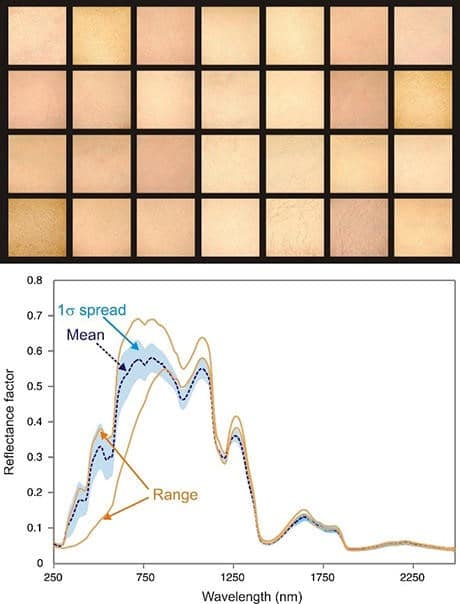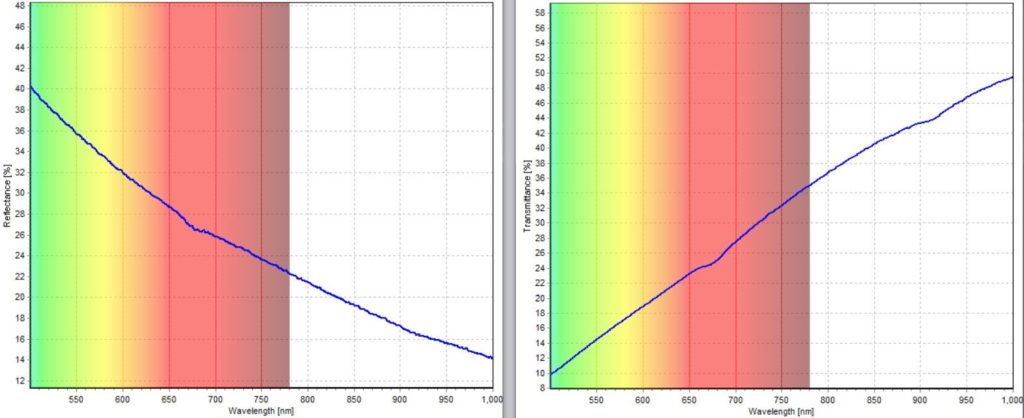Real or Silicon Tissue – a Spectrometer can tell you!
Conducted by: David Ademe (Applications Engineer), Avantes Inc.
Theme: Biomedical, Reflection/Transmission
Background/Applications:
Often times in medical applications, surrogate samples (also known as tissue phantoms) are used to simulate human tissue. Optical tissue phantoms are synthetic models mimicking not only human tissue properties but also light propagation and interactions through it. They are reported to be used largely for three main purposes: to calibrate optical devices, record baseline reference measurements, and for imaging the human body.
In this experiment, we will be looking at the reflection and transmission spectra of several tissue phantoms made of different materials (silicone and 3D printed ABS plastic) and compare the results to real tissue spectra.

Experiment Setup
Description of Methodology:
For this experiment, we will be using a unique setup to measure both transmission and reflection of the tissue phantoms simultaneously. An AvaSphere-50-LS-HAL will be used to illuminate the sample from below. The sample will be placed on the port of the sphere, and this sphere will measure the reflection of the light on the sample. Directly above the sample will be another integrating sphere, an AvaSphere-100. This sphere will collect the light being transmitted through the samples. The spheres will be mounted vertically on our transmission/reflection stage.
Due to the reflection and transmission spectra being measured simultaneously, this experiment will require a dual-channel setup, with one spectrometer dedicated to recording the reflection spectrum and another dedicated to the transmission spectrum.
For the reflection spectra collection, an AvaSpec-ULS2048XL-EVO will be used. Combining exceptional quantum efficiency with high-speed communication is the value proposition of the AvaSpec-ULS2048XL EVO spectrometer, which is crucial in diffuse reflection measurement applications, such as the tissue phantoms. Unlike many back-thinned CCD spectrometers that have two-dimensional arrays, the ULS2048XL-EVO has large monolithic pixels of 14×500 microns with exceptional efficiency in the UV range, from 200 to 400 nm, and the NIR range, from 950 to 1160 nm. The instrument also has an electronic shutter, which enables integration times as low as 2 microseconds.
The transmission spectra will be measured with a separate AvaSpec-ULS2048XL-EVO. This allows for both the transmission and reflection spectrums to be displayed next to one another simultaneously in real-time in AvaSoft.
Test Data and Results
 Analysis:
Analysis:
All five spectra display the same general reflection and transmission curves. This is especially expected from the same types of materials, such as the 3D printed plastics and silicone samples. However, each material does display its own properties, revealing why it is important to test different phantom tissue samples depending on the application, as different materials have different diffuse reflectance/scattering properties.
Diffuse reflection is the reflection of light or other waves or particles from a surface such that a ray incident on the surface is scattered at many angles rather than at just one angle as in the case of specular reflection. Therefore, it is essential to determine the tissue phantom that displays qualities similar to the tissue it is mimicking.
As so many factors can influence the optical properties of human skin, it is difficult to pinpoint a typical optical signature of human skin. Key contributors to the spectral structure of human skin include water, melanin, and hemoglobin. According to NIST, there is a large range and spread in the reflectance of human tissue.
Therefore, the different reflection and transmission spectrums in the tested samples are indicative of the difference in optical properties in tissue, demonstrating the need for accurate tissue phantom samples depending on the application.
Conclusion:
The reflection and transmission spectra from the tissue phantoms prove that Avantes instruments provide an excellent method of identifying key optical properties in samples, such as tissue phantoms. In particular, the AvaSpec-ULS2048XL-EVO is an excellent and reliable spectrometer for applications requiring high sensitivity.
Upon evaluation of the spectra collected, the data is consistent with known reflection and transmission spectra of tissue. Further testing could reveal even more unique spectral properties of tissue phantoms, depending on the study. Please contact your Avantes sales representative to determine how Avantes instruments can assist your application.
 My Cart
My Cart 


